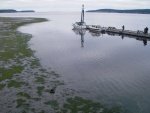Although the newer RIB are lighter in weight--they still have challenges for the total weight. You can deflate the tubes, and some fold the transom in, to get the profile down. One way that RIB's are "cradled" is with SS tubings, which act as "bunks" under the hull itself. You can put the "pipe insulation foam" over the tubing to pad the bottom of the boat. The type of cradle depends on the amount of "V" or dead rise.
To get a bigger inflatable, you will probably want a longer tube on the Garhauer Davit, so you have a higher lift. You also want to have the heavier capacity davit (larger tube) and the longer arm. I have done this, but don't have any photos, and am in Calif. currently.
Also consider the aluminum bottom inflatable. Fiberglass will wear on the rocks and sharp sea food shells in AK. We had a 12.5 foot Avon RIB when we cruised AK in our Cal 46. We brought it aboard, with a roller (solid SS bar with trailer roller) across the entire transom. We used an electric winch and the boat rested on teak strips, screwed to the deck. This inflatable had a double hull (bottom and deck): Each season, we put a sacrificial strip of fiberglass mat down the length of the keel, where the RIB contacted the rocks/shells. We put this on with epoxy mixed with aluminum powder to give it more abrasive resistance, and faired this--then painted with a hard bottom paint.
We have also used fabric bottom inflatables in all of the inland passage as well as Ak. If you are careful, the fabric bottom inflatable will work fine up North--and you can glue extra strips of material on the places where there might be cuts or wear.
Because of the high tides, and sometimes difficult beaches, we rarely beached the inflatable as we did most other places. We would use boots going ashore, to avoid major contact with the rocks/shells. We would anchor the RIB or inflatable off the shore. We had a 200' "endless line. The anchor for the inflatable had about 6 feet of chain, and a pulley on the end of that. The line went thru the pulley. We would drop the anchor just about 100 feet off the beach, power or paddle the inflatable to the beach. A point on the line would be attached to the bow eye of the inflatable, so that the boat could be pulled off the beach. We also had a light stern line as a "safety". After we disembarked in shoal water, we pulled the boat off the beach, and attached the safety line and a couple loops of the anchor line to a branch, sand spike or deadman on the beach (being careful that would be above water at the highest tides.
An example of a boat suitable for a C Dory 25 would be the Achillies HB 275F. This is 8'10" long, 17" tubes, and weight 86#--no engine. The transom folds.
The 7'10" aluminum boat weighs 88# and the 8'10" weight is 98#.
In the past a Portland Porgy has been carried on the roof of a C Dory 25--I thought it was a bit awkward--but the owner was happy--perhaps not the easiest to get on the roof.

